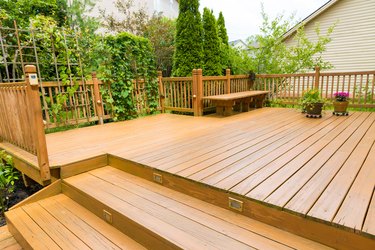
Some tree species contain chemical compounds in their wood that provide a natural resistance to the microorganisms that cause decay, and this natural resistance means that these wood species are more durable in terms of rot when they are used for outdoor building projects. Among the most decay-resistant species are those in the cedar family, including Western red cedar and Eastern white cedar.
How Cedar Naturally Resists Decay
Video of the Day
The decay-fighting chemicals are in the greatest abundance in the tree's heartwood, the dense wood near the center of the trunk, and much less so in the sapwood in the outer part of the trunk. Consequently, lumber made from heartwood is much more resistant to rot than is lumber that contains sapwood, which is not significantly more durable than nonresistant species.
Video of the Day
In outdoor structures that are not in contact with the ground, such as decks, gazebos, pergolas and fence boards, cedar may last 30 years or longer. When in contact with the ground, such as when it's used for fence or support posts, it can last between 15 and 20 years.
Treating With Chemical Preservatives
Pressure-treated lumber is made from a non-decay-resistant wood, often Southern yellow pine, that is infused with a chemical treatment that prevents decay. In modern pressure-treated lumber, the most commonly used preservatives include alkaline copper quaternary (ACQ) and copper boron azole (CBA).
The lumber's longevity depends on how much preservative is in the wood, a characteristic that varies among grades of pressure-treated lumber. For above-ground use, wood with 0.25 pound of preservative per cubic foot is adequate, but wood that will be in contact with the ground, such as that used for fence posts, pergola posts or deck posts, should contain 0.4 pound per square foot. When the proper grade is used, pressure-treated lumber can last more than 20 years.
Tip
The rating or grade of pressure-treated lumber is displayed on a grade stamp -- applied to the face of the lumber -- or on a tag stapled to the ends of boards. Standard-grade lumber carries labels such as "Above-Ground" or "For Above Ground Use," while heavily treated lumber for ground contact is labeled "Ground Contact."
Hardness and Strength Characteristics
In terms of physical characteristics, cedar differs from pressure-treated lumber because of differences in wood species apart from their decay resistance. Red cedar is, for example, not as hard as yellow pine, making it more vulnerable to gouges and scratches when used in applications such as deck flooring. The bending and compressive strengths of cedar are less than those of pine, too, which make it less capable in important structural roles.
Cedar Vs. Lumber: Cost Differences
Cedar's principal advantages over pressure-treated lumber are its freedom from synthetic chemicals and its attractiveness. Those advantages come at a significant cost, however. The best grades of cedar — those that contain primarily heartwood and are free from cosmetic defects — typically cost several times as much as comparable pressure-treated lumber. The cost varies regionally, though, and in areas where cedar is more prevalent, its cost will be lower, although never as low as that of pressure-treated pine.
Tip
Use the right fasteners: For cedar, use stainless steel or aluminum nails or screws. Neither of these will "bleed" dark streaks onto the wood. For pressure-treated lumber, use stainless steel or hot-dipped galvanized fasteners. Other types of galvanized fasteners are more prone to corroding in treated wood.